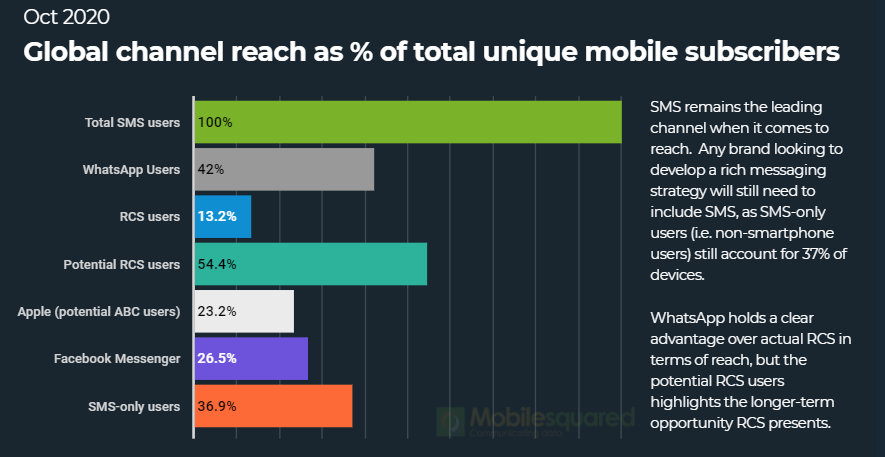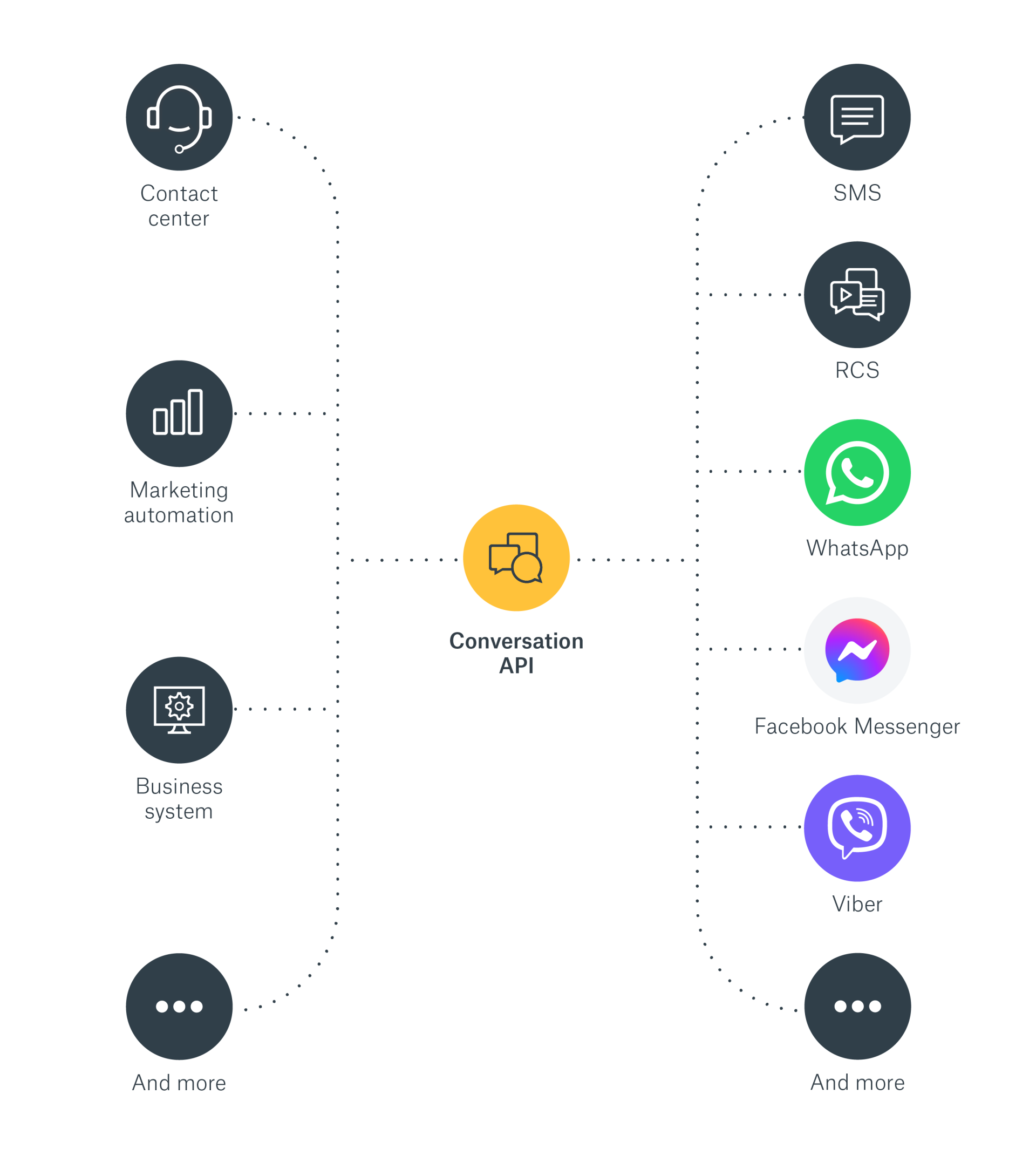Insights, Products
Keys to a multichannel mobile strategy

Insights, Products

As mobile channels enter the marketplace, customers expect more than simple alerts. They want to be able to chat with businesses in an accessible and user-friendly way. That means meeting them on their preferred channel. As new chat channels emerge on the market, regional user adoption is growing but it varies by geography. Regardless, this is where consumers are spending time and looking to engage the brands they care about.

SMS appeared on the market 28 years ago, supporting a 160-character message. For businesses, it’s a useful tool for immediate reach and time-sensitive alerts like account verification. Over time, shortcomings were noticed with international Person-to-Person (P2P) SMS. Because of the character limit and regional differences, users have switched to Over-The-Top (OTT) chat apps like Facebook Messenger, WhatsApp, Viber, Line, and a host of others.
SMS is still essential for A2P messaging and should not be overlooked while adding new channels. According to Mobilesquared: “SMS remains the leading channel when it comes to reach. Any brand looking to develop a rich messaging strategy will still need to include SMS, as SMS-only users (i.e., non-smartphone users) still account for 37% of devices.”

Over-The-Top (OTT) chat apps support rich media, higher character limit, read receipts and group chat capability, connecting users in regions where SMS is less widely used. As of February 2020, WhatsApp announced a userbase of 2 Billion monthly active users globally.
WhatsApp and Facebook Messenger are growing about twice as fast as the original Facebook platform (+30% YoY). WhatsApp is the most used messaging app in the world. Suppose you combine all the apps in the Facebook universe, including WhatsApp and Instagram. In that case, there are only ten countries where a member of the Facebook family isn’t leading the market.
Looking at monthly active users for the top 3 most popular messaging apps, it’s clear how popular they are. WhatsApp, Facebook Messenger, and WeChat combined have more than 4 billion active monthly users.
While OTT chat apps are popular, RCS is a promising channel entering the landscape. RCS is the next-generation of Application-to-Person (A2P) messaging, transforming the native SMS inbox into an app-like experience. Global operators are rolling out P2P RCS slowly, but the A2P benefits are truly remarkable; rich carousels of product offerings, check rewards balances, make purchases, ask the questions in one continuous conversation, and more.
Research from Mobilesquared predicts: “while WhatsApp holds a clear advantage over actual RCS in terms of reach, “the potential RCS users highlights the longer-term opportunity RCS presents.”

Until RCS is fully rolled out, consumers will undoubtedly continue to use OTT applications for business chats. Facebook merging with WhatsApp Recently, Facebook announced plans to merge WhatsApp and Facebook Messenger to offer one chat application with a combined monthly active user base of nearly 3 billion people globally. This is a massive active user base and one that brands like eBay are already rushing to capitalize on. eBay announced their plans for “Buy Now’ capability within Messenger some time ago. Imagine the reach and simplicity of conversion once these channels are combined.
It’s time brands take notice and use a multichannel strategy for communicating with their customers.
As new chat channels appear on the market, uptake is growing. But as the chart above shows, this varies greatly by region. Regardless, this is where consumers are looking to engage – it’s time for brands to take notice and use a multichannel strategy to communicate with their customers.
Let’s start with customer experience. Self-serve in the moment of need is a sign of excellent customer service. Users want to multitask and prefer customer support that fits in with their timetable. Creating a chatbot for FAQs, like checking a balance, confirming an appointment, or submitting returns, reduces support overheads and enables customer care teams to focus on more complex requests.
Brands might be missing a secret – the value of the service journey. There are many touchpoints along the timeline of support resolution that could easily transform a customer into a lifelong brand advocate. Personalization is key here, and with it, a business can deliver gold-standard service by understanding customer needs, intent, and context.
Marketers are at the spearhead of brand awareness and promotion. If a message or notification is personalized, it’s far more likely to be welcomed than ignored. Timeliness and relevance for promotions, abandoned cart reminders, and loyalty offerings can make or break a user’s brand association. A full 360-degree view into preferences, activity, and habits helps create an engaging customer journey rather than a fragmented one.
One advantage of chat apps is that consumers already understand how to use them, because they already do daily. In the 2020 Mobile Consumer Engagement Report, we found that: “71% of consumers say they “often” or “sometimes” silence push notifications on their phones.” Meanwhile, “40% of consumers say they have at least 50 unread emails in their inboxes, but just 4% say they have 50 or more unread mobile messages.”
In particular, Millennials are tired of impersonal spam and are longing for “conversations” with the brands they care about. Without the need to download an app or check their email to communicate with a business, the intuitive and frictionless nature of chat apps offers this in spades. Further benefits of rich media are quick replies, embedded links, video, voice, and personalization in a conversation. And if the user changes apps, retaining the conversational context for that full 360 view.
Today, most major marketing clouds have focused on email since it remains the workhorse of digital media. However, most enterprises are seeing subscribers abandon email in droves, with open and conversion rates dropping. Yet most enterprises continue with a proactive “batch and blast” approach to email where there is little, if any personalization or relevance. While most of these players embraced SMS some time ago, they are all late to the game in terms of addressing these new channels that are becoming more and more important to consumers.
This is understandable when you consider the cost and complexity that goes along with integrating each of these channels into their existing platforms. With feature sets and APIs continually changing and users in different regions preferring different chat apps, who can blame these marketing cloud players for being somewhat late to the game.
Luckily, Sinch has the solution.

Each channel has unique formats, compliance, and requirements. Plus, their APIs are constantly evolving.
Conversation API has the answer – a generic ‘Omni-message’ that’s designed only once to match the individual’s channel of choice
A gold-standard customer experience means being available on your users’ preferred channel. Conversation API makes it easy to receive and respond to customer requests, even if they switch channels. Access continuous and contextual chat history. Continue the chat on the most recent channel or set a custom priority. Reduce support overhead by automating FAQ so your support team can focus on the most complex requests.
Offer customers a personalized chat experience on their preferred channel, whether it’s marketing-, service- or operations-driven. Conversation API currently services SMS, RCS, WhatsApp, Facebook Messenger, and Viber, and we’re adding new channels all the time to keep up with key customer requirements around the world. If you’re new to multichannel messaging and want to understand how to harness the power of Conversation API, the experts at Sinch can help.
Are you interested in getting your multichannel messaging strategy off the ground or add to your future channels?
Learn more about Sinch Conversation API.